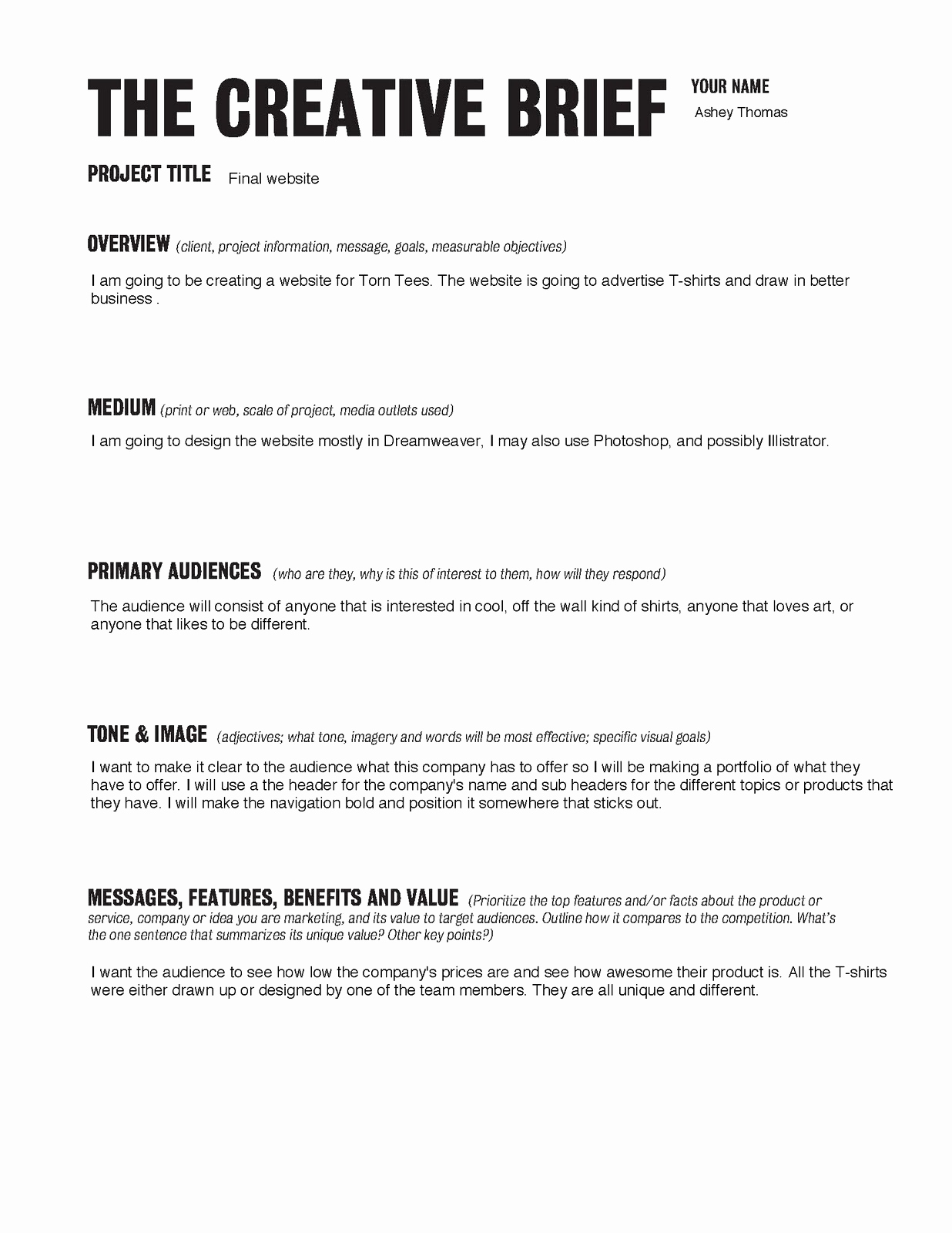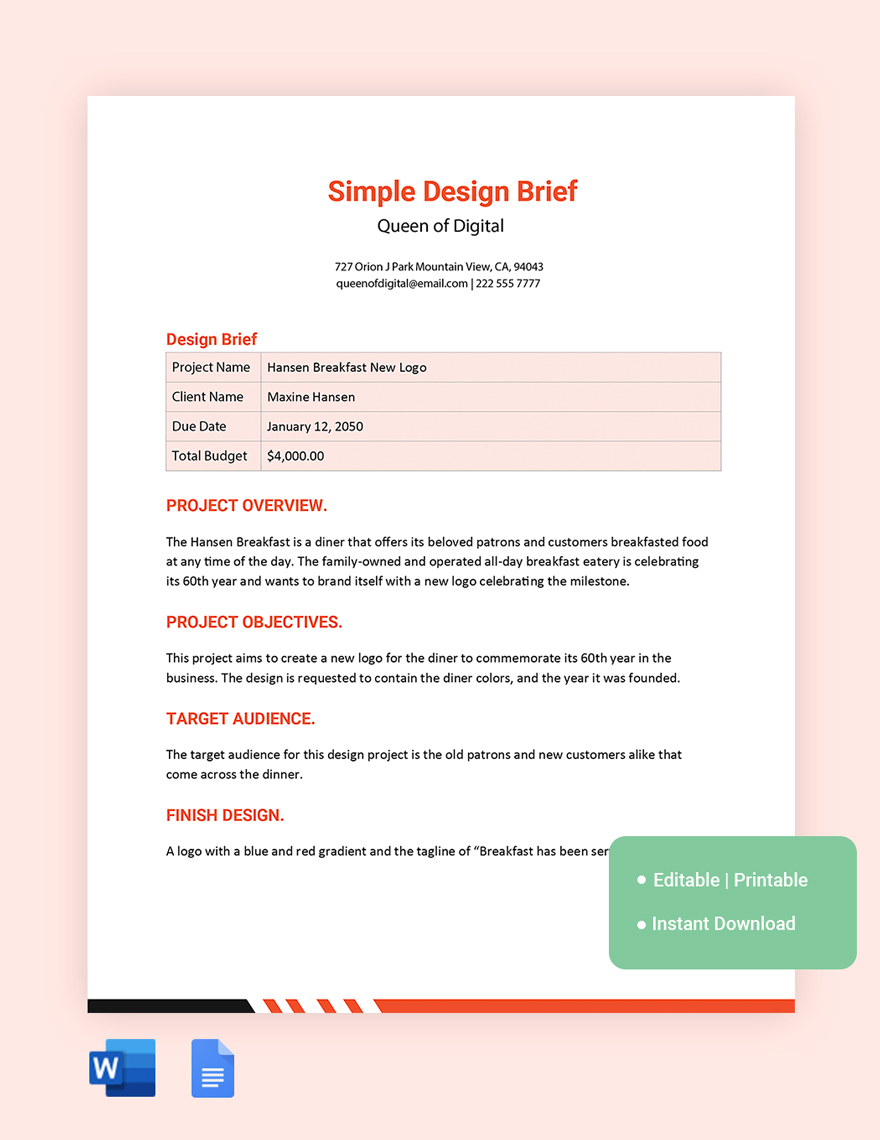Table Of Content

Include a link to any previous marketing materials or other relevant content from the client, if applicable. This will give you a better understanding of their existing branding and help inform your design choices in the future. A document that provides the specifications for a specific design project is known as a Design Brief Template. Provide details about the preferred aesthetic look and any other crucial specifications or rules. Create a quick guide for your creative team with this design brief template. Outline the strategy of your brands and projects using this creative brief template.
Event Planning Creative Brief

While a poorly written brief can set the client and designer up for failure. When the project is done, you’ll need to make sure your audience actually sees it. List a few channels or platforms on which you plan to announce the launch, as well as any promotional content you plan to create. Your creative brief might include several different CTAs, especially if you have a primary and secondary target audience.
Free Creative Brief Templates
Among other important elements, your creative brief is your opportunity to define the scope, deadlines, and deliverables specific to the creative part of your project. Ideally, take a little time to create a template for your design briefs which is customized to the specific kind of work you do. There is no one-size-fits-all; the exact information you need is defined by your own design process and preferred way of working. Although every part of the design brief is important, ensuring that you and the client have a shared understanding of project deliverables is fundamental to a successful project. Without this, you could reach the end of the project before you discover you’ve created the wrong thing.
Manage Your Upcoming Design Project With ClickUp
When you find a creative brief template you like, you can either download it as is and start using it right away or customize it with your own colors, fonts, text, images, icons and more. You can also make your creative brief interactive if you plan on sharing it online. Add links, embed videos, forms and quizzes, add animations and popups, and much more. Outline your partnership strategy in an effective way using this creative brief template.
At this point in your creative brief, you want to define the specific business need and what the work will accomplish. At the end of the project, you’ll want to look back on them and clearly know if you’ve met your objectives. Just like any other task, creative work deserves a clear plan and measurable goals before work begins. Developing a creative brief allows you to take a proactive approach and outline requirements while planning out your creative work.
How to write an inspiring creative brief
PandaDoc is not responsible for examining or evaluating such Third Party Materials, and does not provide any warranties relating to the Third Party Materials. Links to such Third Party Materials are for your convenience and does not constitute an endorsement of such Third Party Materials. This will help you stay organized and ensure that you can meet all of your deadlines in a timely fashion. While it may seem like a design brief will be a massive document – and even bigger depending on the size of the project – that’s not the case.
Crafting an effective designer brief: guidelines for success
After an overview of the project and company is complete, it’s important to explain the goals and objectives for a project. This section should focus on the design problem to solve and the steps your team will take to fix the issue. In this guide, we cover what a design brief is, the benefits of creating one, how to write a design brief, and the elements you should always include.
A well-done design brief give both parties a solid layout for how they’re going to accomplish their goals. It’s a great guide to look back on if one party ever feels like the progress is getting off track or a disagreement arises. For more details on the app’s features and functionalities, visit our Digital Whiteboard section.
Goals and objectives
Anatomy of a Great Creative Brief – PRINT Magazine - PRINT Magazine
Anatomy of a Great Creative Brief – PRINT Magazine.
Posted: Mon, 13 Oct 2014 07:00:00 GMT [source]
Assigning these roles at the beginning of a design project creates accountability while eliminating the “too many cooks in the kitchen” scenario. Designers must know who has the final say to avoid adding features or taking instructions from the wrong people. Here are some design brief templates from popular project management tools.
You can avoid having to circle back to questions and conflicts down the road by putting the appropriate information in your creative brief up front. Know that getting the answers you need from the get-go will make for a more relaxed designer and a more satisfied client in the end. You’ll be able to rest easier knowing that the foundation of your project is as solid as a rock. No matter how you choose to develop the brief, don’t be afraid to ask questions.
We are open to innovative ideas but must ensure the app remains intuitive for new users. The objective is to design a mobile app that stands out in the crowded productivity market by focusing on ease of use, collaboration, and customization. We aim to acquire 10,000 active users within the first three months post-launch.
It clarifies the problem the design will address, the proposed solution, and the target market the solution is designed for. This is also an opportunity for you to clarify the project scope, which outlines exactly what is needed to accomplish a project. The scope of the project should be agreed upon by both parties to avoid confusion or tension throughout the design process. Please refer to our Virtual Whiteboard for inspiration, brand assets, and contact details for the project manager. We do not want the rebrand to stray too far from our original color scheme to ensure brand recognition among our current clientele. Designers need to know when the project is due for its first round of edits, when they can expect feedback from the client, and any key milestones, task dependencies, or deadlines tied to the request.
For the purpose of this article, we'll use client and company interchangeably to represent the party commissioning the design project. Your team will find the type of brief that serves your design project management style best in terms of length, detail, and work style. Small requests or smaller-scale projects may not require as hefty of a brief, but there are still key elements that all briefs share. With FigJam's editable template, it's easy to add visual elements and inspirational images, in addition to writing descriptive text, so feel free to exercise a multi-media approach.
These are typically business or marketing-related metrics like increasing conversions or reducing a website’s bounce rate. Summaries are essential for stakeholders who typically don’t need too much detail but want to understand the purpose of the design project. Having a clear, realistic and measurable goal will help keep your team on the same page. For example, are you trying to increase inbound leads, or double the number of sales enquiries in 1 year?
Most importantly, it’ll outline the problem designers must solve or the purpose of the design project. If you are using a tool like Nuclino, you can collaboratively edit your brief in real time and comment on specific sections. The document can be easily shared with external stakeholders using a shared link. Finished deliverables – files, images, Figma designs, and so on – can be embedded or uploaded directly into the brief, making it easy to manage your entire design project within a single document. Once you have created your brief, don't forget to keep it up-to-date and make sure to make it easily accessible to all relevant stakeholders.
Specify how you will reach your audience once your assets and deliverables are ready. Marketing and design are almost always involved, and oftentimes other departments will also play a part. This means several individuals from different teams working together on the same desired outcome. If you can tell a budget or schedule isn’t feasible, let them know and try to suggest an alternative or scaled-down solution instead. If you don’t have the capacity to meet their needs, try to refer them to another designer you know and recommend. This will help preserve your relationship with the client for the future, and may leave the door open for other work.

No comments:
Post a Comment